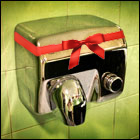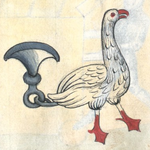|
Doctor Malaver posted:The obvious weak spot was the d4 pawn, especially after 10... d6 which blocks the bishop. After b3, Bb2, Nf3, Black would have problems defending it. I don't have a board in front of me right now, but I remember dismissing the dark squared Bishop fianchetto because of the problem of my light squared Bishop running out of squares against a a6-b5 push.
|
|
|
|

|
| # ? May 10, 2024 13:30 |
|
That's right but after the first attack on the pawn with Nf3, Black can only defend it with Qb6 which blocks his b pawn. Also, you can do a fianchetto with b4, not necessarily b3. I'm not providing the exact sequence of moves, just the idea to press on the weak d4 pawn. Sometimes you need to invest quite a few moves in weakening down a pawn.
|
|
|
|
Thoughts R1: If you're having trouble improving your pieces, try to figure out what the ideal square would be for all of your pieces. Around move 10, for you, you only really have one piece fully developed: your light squared bishop. On the other hand, both your rooks and your dark squared bishop are not just undeveloped but have no prospects. Your first task, then, before attacking, is figuring out how to optimize them. Playing f4 is a good idea, since it both gives your one rook scope and it fights for the e5 square (which is a key square for black). The other feature of the position that's relevant for piece development is the c-file. Controlling open files is important, and largely what decided this game ó if black can't bring the queen in via c2 then there's no counterplay. As far as long term plans, here are two good rules of thumb. The first is that you should only launch a pawn attack on the wing if the centre is under control (which usually means that the centre is not just closed but locked, although there are exceptions). If the centre isn't under control, it's very easy for the other player to counter by breaking in the centre, even if they're sacrificing a pawn (or sometimes more). Similarly, if you're ever facing down a pawn storm on the wing, look to break in the centre as quickly and forcefully as you can. Once the centre is open, the wing-side often goes from attacking strength to defensive liability, as you saw when black took advantage of those big, open diagonals. The other rule of thumb is that when you're attacking, you want to have more pieces in the attack than your opponent has defenders. This rule is a good way to orient your attack, since you can prepare for your attack by, in the words of Jacob Aagard, "bringing all your toys to the party." Your rook on a1 never does anything, your opponent's rook on a8 never does anything. If you bring your rook over before his, that's a big difference. Lastly, a tactical thing. When attacking, it's always a good thing to keep in mind what your opponent's weak squares are even if you're not directly attacking them. On move 24, when you played Ng5, the key square is f7. And you keyed in on that, and played Ng5. However, if you're attacking f7, they you need to get multiple attackers on it, which means clearing out the defending bishop on f6. Better, then, is 24.g5, when you clear the bishop out the way. You now have the idea of moving your knight away with something like Ne1, with a double attack on the queen and the pawn on f7. You can't do that yet (Qxh3+ is a threat), but you now have a powerful threat that both orients your plans and forces your opponent to react. R2: Yeah, you do have to play f6 at some point to kick out the knight and fight for the e5 square. Your diagonal does become weak ó playing f6 is a concession ó but the alternative is just running out of space. A good way to orient your play in these sorts of positions is how you cover that weak diagonal (and donít play f6 until you can cover it). But also note that your opponent played d5 pretty early. That pawn blocks the diagonal, and you in turn can blockade that pawn with Bd6 (or, even better, Nf5-d6). In these sorts of positions, you also always need to have in mind how youíre going to get active, so youíre not just waiting to lose eventually. This doesnít just mean getting in one marauding queen, which can be pushed back, but how youíre actually going to get some space for yourself where you can use all your pieces. Iím not an expert in these sorts of positions, but two ideas for you come to mind. The first is preparing f6 by putting a rook on e8 (and maybe your queen on f8). Your idea would be to follow up f6 by trading one pair of rooks on e1, and then bring your other rook over to e8. Youíd maybe then fight for the file by playing Re7 and Qe8. This both gives you some space to use, and also trades off your bad rooks for his good rooks. The other plan, which Iíve seen sometimes, is getting a f6-g5-h6 pawn structure, putting the king on g7, and then preparing h5 with something like Rh8. Karjakin did this in the match against Carlsen. However, I donít know the particulars of this kind of plan. As a last sort of side point, from what I know of the Berlin, you often really want your light squared bishop in this kind of reduction. See how whiteís queenside pawns are all going to be lined up on the light squares? You can actually reliably win the opposite coloured bishop endgame in these sorts of reductions. Having these ideas in your back pocket can also help you make decisions in game. R3: Yeah that went horribly wrong. I know nothing about this opening, but it seems kinda suspicious to me that that youíre giving white so many pawns in the centre before you develop. R4: This is a really basic game, which I mean in a good way. Your opponent gives you something to play around (weak d5 square, backwards d pawn), and you methodically build up your attack on the weaknesses before breaking through. Iím curious as to what you think your ďwaiting movesĒ were. If itís stuff like doubling your rooks, those arenít waiting moves. Thatís the sort of active plan you should be taking in this sort of position. If your opponent didnít play Qf6 when he did, giving you a concrete attack, then your next task wouldíve been to improve your lightsquared bishop. Another possibility is h4-h5, pursuing the twin tasks of opening h3 for your bishop, and clearing the g6 pawn so you can put your knight on f5. One thing Iíd be wary of here is your loose knight on e3. Your opponent could engineer playing f5, which could create counterplay. It fails here for tactical reasons, but he could shift his queen off e7. R5: So I think your play up to move 19 does a good job of keeping the game balanced. When we get to move 19, two things stick out. The first is that your main task in this position is figuring out what youíre going to do with your knight. It is very easily misplaced in these sorts of positions. I suspect that your knight would actually rather be on c6 than c4, where it can support ideas like playing b4 then d4 to create targets or open squares on the queenside. The other thing that sticks out is playing g6. I think this just creates targets for white. Unless a move like this directly and concretely contributes to your defence, youíre probably better off returning your knight to civilization. R6: First thought: Be7? Isnít this very passive? Is there a reason why you donít play Bc5? This actually seems to have a pretty significant knock-on effect. Playing these positions as black, I usually go with moving my queenside knight from c6 to g6, but you canít do that with the bishop on e7. As for whether you should sacrifice, returning to what I wrote for game 1, unless you have a super concrete mate, you shouldnít make a move like Bxh3 if youíre not going to end up having more pieces in the attack than your opponent has in the defence. (Similarly, if you are going to have more pieces in the attack than your opponent has in the defence, a sacrifice can be good even if you canít see it all the way through.) As for what you can do instead? To start, you havenít finished your development, so bring youíre a-rook into the game. The bishop pin on your knight seems unpleasant, so consider a6-b5, which would also let you bring your knight over to g6. Once the knightís on g6, a frequent idea to improve is to play Nf6-h5-f4. As for studying these sorts of games, if it looks like players are doing a lot of random shuffling, look over a game or two with the specific goal of asking yourself what every move is supposed to accomplish. This doesnít have to be a direct tactical threat ó it can be basic stuff like improving a piece or taking space.
|
|
|
|
Thank you for giving your time to review my games. I have some work ahead of me. I played only 4 tournaments this year since I was busy interviewing for my first full time job. Now that I found one, I will play much more often and hopefully fix my common mistakes.
|
|
|
|
How can I learn to recognize a mate from like 13 moves out? I won the below game in 68 moves but the chess.com engine started saying I had a path to mate around the early 40s. [Site "Chess.com iPhone"] [Date "12/31/2016 04:03PM"] [White "Arrgy (840)"] [Black "turkerin (832)"] 1.Nf3 e5 2.d4 d6 3.g3 c5 4.c3 Bg4 5.Qd3 a6 6.Nbd2 f5 7.Bg2 e4 8.Nxe4 fxe4 9.Qxe4 Be6 10.Qxb7 Nd7 11.Qc6 Ngf6 12.Ng5 Rc8 13.Qxa6 Bg4 14.O-O Ne4 15.Nxe4 d5 16.Nd6 Bxd6 17.Qxd6 cxd4 18.f3 Bh5 19.h4 dxc3 20.bxc3 Rxc3 21.Bg5 Qa5 22.Qb8 Nxb8 23.f4 Bxe2 24.Rfb1 Kf7 25.Rb7 Ke6 26.Re7 Kd6 27.Rxe2 Qb6 28.Kh2 h6 29.Be7 Kc6 30.Re6 Kb7 31.Rxb6 Kxb6 32.Rb1 Kc7 33.Bxd5 Rc2 34.Kg1 Rxa2 35.Rc1 Kd7 36.Bc5 Ra5 37.f5 Rc8 38.Be6 Kc7 39.Bxc8 Kxc8 40.Bb6 Kb7 41.Bxa5 Ka6 42.Bc3 Nd7 43.Bxg7 h5 44.f6 Nxf6 45.Bxf6 Ka5 46.Rc5 Kb6 47.Rxh5 Kc6 48.Rf5 Kd6 49.g4 Ke6 50.h5 Kf7 51.h6 Kg6 52.g5 Kh7 53.Kg2 Kg8 54.Kg3 Kf8 55.Bg7 Ke7 56.h7 Ke6 57.Kg4 Kd6 58.h8Q Kc6 59.Qc8 Kb6 60.Qc5 Ka6 61.Rf6 Kb7 62.Qc6 Kb8 63.Rf8 Ka7 64.Rf6 Kb8 65.Qb6 Kc8 66.Rc6 Kd7 67.Qc7 Ke8 68.Re6# {Arrgy won by checkmate}
|
|
|
|
|
Arrgytehpirate posted:How can I learn to recognize a mate from like 13 moves out? I won the below game in 68 moves but the chess.com engine started saying I had a path to mate around the early 40s. You don't have to see all the way until mate when you have an overwhelming position. Engines will brute force calculate all the way to the end and say "mate in 20" or whatever, but we humans have the luxury of saying "I'm a piece up so I'll win easily" without having to calculate too much. You just have to Queen a pawn and make sure you don't accidentally stalemate your opponent. Make sure you know the basic "overwhelming advantage" mates, such as Queen and King vs. King, 2 Rooks and King vs. King, and 1 Rook and King vs. King. There are Youtube videos out there that explain them.
|
|
|
|
Arrgytehpirate posted:How can I learn to recognize a mate from like 13 moves out? I won the below game in 68 moves but the chess.com engine started saying I had a path to mate around the early 40s. Yeah, no one can really do this unless it's an extremely straightforward endgame line. Like Unfurled Sails said, you generally want to calculate your way to a clear advantage.
|
|
|
|
Try to understand what's going on in a position before calculating. You need that to orient your thinking. Also calculating is tiring so you should try to do it no more than you absolutely have to.
|
|
|
|
Arrgytehpirate posted:How can I learn to recognize a mate from like 13 moves out? I won the below game in 68 moves but the chess.com engine started saying I had a path to mate around the early 40s. As others have said, you don't have to brute force calculate your way to a win if you have overwhelming advantage. So for instance, in the game you posted, here's the position after move 43. ...h5:  You look at the big picture - you're up a whole rook and 2 pawns, with a passed pawn 3 squares away from queening. Furthermore your rook constrains his king to a small part of the board. So the main issue is, what is the method to win, to checkmate Black's king, from here? The way to do it is to queen your f pawn, or force him to sacrifice his knight trying to prevent this, after which you queen one of your other pawns. You don't have to calculate out the exact sequences of moves as long as you know the method. In the position, the only way to prevent the f pawn queening is for Black's knight to either capture or blockade the pawn at f6 or f8, after which White's bishop takes the Black knight off the board and Black can't make any moves except with his king. At this point there are two ways to win. You can either leave the pawns alone entirely and administer mate with White's king and rook, with maybe a little support from the bishop, or you can use your rook to keep the Black king in prison on the left side of the board while the White king comes around and removes the final Black pawn and then queens his g or h pawn and uses queen and rook to administer mate. As long as you know the method of administering mate with your King and Rook against a lone King, you don't need to do much calculation as long as you avoid stalemate and throwing away your rook. You do need to be able to perform the method efficiently so you don't wind up throwing away a won game into a draw or loss because of time. As far as checkmates against a castled position if you play and study a lot of games you will recognize patterns where certain types of mating attack can be applied. For instance if White is king side castled and advances his h pawn to h3 to drive away a pesky bishop or knight from g4 or prevent a knight or bishop from landing there, that's a pattern where under the right circumstances Black could sacrifice a bishop for the g and h pawns in order to peel open the White king's position for a mating attack. But here calculation IS important, if you are making such a sacrifice you have to be pretty certain you can either administer mate, force White to give up enough material to compensate the sacrifice in order to prevent mate, or wind up with positional advantages that at least compensate the loss of material. Mating attacks that come up one move short result in losses much of the time. Another example of patterns: If White is king side castled but has fianchettoed a light squared bishop to g2 as part of his defense, there are methods to either drive away or force the exchange of those bishops. Once the bishop is gone, the light squares around the castled position are available for queens, knights etc. to park on as part of a mating attack. Again the specific calculations are very important particularly if material sacrifice is involved. If you've ever been a victim of, or administered, a smothered mate, it has a very specific pattern of weakness in the castled position that leads to the possibility of smothered mate. You learn to see it as it appears, or even a move or two ahead if you're trying to create that position.
|
|
|
|
I was playing a game of blitz with my coworker and we ended up in a position very similar to this(I don't remember exactly where the kings or rook were, because, you know, blitz): My thought, even at the time, was that this is a draw; black has a fortress here, since the bishop hold f4 and if white ever trades his rook for the bishop and pawn black can go Kf6 and that position is trivially drawn, but I was wondering if there's a path white can take for victory, maybe by adding in a mate threat or some such.
|
|
|
|
Elyv posted:I was playing a game of blitz with my coworker and we ended up in a position very similar to this(I don't remember exactly where the kings or rook were, because, you know, blitz): If White can come up with a sequence of moves where he exchanges the rook for Black's bishop and pawn but can maintain the opposition in front of his pawn then it's an easy win. I don't know if there's a way to force this though.
|
|
|
|
Ugh. I need to learn not to get too excited when I play. I can think of at least three games where I saw a mate and went for it but they also had a mate and were a move ahead. I get so proud of myself when I see a mate two or three moves ahead I tend to ignore what my opponent does and move forward with my plan.
|
|
|
|
Arrgytehpirate posted:Ugh. I need to learn not to get too excited when I play. I can think of at least three games where I saw a mate and went for it but they also had a mate and were a move ahead. I get so proud of myself when I see a mate two or three moves ahead I tend to ignore what my opponent does and move forward with my plan. Ooh boy wait til you discover Shogi and both players are almost ready for a mating net for half the game.
|
|
|
|
|
Elyv posted:I was playing a game of blitz with my coworker and we ended up in a position very similar to this(I don't remember exactly where the kings or rook were, because, you know, blitz): This is winning for White (confirmed by tablebases) but it's not trivial. The winning plan is to use the king+rook to force Black's king onto the d- or h- files, or the 8th rank, and trap it there with the rook while you prepare Rxf4.
|
|
|
|
I just want to say playing bullet is ridiculous and pretty fun. I've actually seen some improvement in classical and blitz because having to move so quickly for bullet and relying on instinct when it comes to a position has made things so much more clear when I have time to think. Or it's all in my head, which is entirely possible. I'm also having a hard time with 1. d4. I'm not a fan of neither the King's Indian nor the Grunfeld, and QGD (and accepted) don't feel that great.
|
|
|
|
RoflcopterPilot posted:I just want to say playing bullet is ridiculous and pretty fun. I've actually seen some improvement in classical and blitz because having to move so quickly for bullet and relying on instinct when it comes to a position has made things so much more clear when I have time to think. Or it's all in my head, which is entirely possible. I know someone who got all the way to ~2430 basically just by playing blitz. Faster time controls can be good for focusing just on what you know, and avoiding thinking yourself into mistakes. What are you not liking about the KID/Gruenfeld/QGD? What do you play against 1.e4?
|
|
|
|
Hand Knit posted:I know someone who got all the way to ~2430 basically just by playing blitz. Faster time controls can be good for focusing just on what you know, and avoiding thinking yourself into mistakes. KID/Gruenfeld is kind of wonky because of Bg7 and I just have a hard time with the lines and attacking from the outside. QGD I just never feel that great about like 4. cxd5. Against 1.e4 I play the French almost exclusively and prefer playing 1. e4 e6 2. d4 d5 3. e5 c5 - give me those knights jumping around all day. I guess this makes sense because my Bishop play is horrible and even in the French I usually spend the first half of every game playing like I'm down the light Bishop because he's not going anywhere until like move 1,000. Maybe I need to give the Gruenfeld another chance. Typing all of this out makes me feel not so secure with unfamiliar opening lines (compared to how much I've studied the French in comparison) so that could also be the problem.
|
|
|
|
If you play the French, and you don't like lines with your bishop on g7, maybe try Nimzo/Bogo type lines? 1.d4 Nf6 2.c4 e6 3.Nc3 (Nf3/g3) Bb4. It's much more energetic than the QGD. Or you can try ye olde Slav, where you can recapture on d5 with your c-pawn, and thus get a completely different kind of game from the QGD.
|
|
|
|
RoflcopterPilot posted:I'm also having a hard time with 1. d4. I'm not a fan of neither the King's Indian nor the Grunfeld, and QGD (and accepted) don't feel that great. The Tarrasch Defense is often erased in discussions of 1.d4, but it can be a useful tool, especially since you can use it against English and KIA players. This is more suited to aggressive players since it concedes structural health for attacking chances though. As a French player, I imagine the Slav might be your future home. Bodyholes fucked around with this message at 20:28 on Jan 4, 2017 |
|
|
|
I'd like to create some clear, realistic, focused goals for improving my play this year. I've read about improving some and I know I don't want to make my goal achieve X rating since with a proper study plan my rating should go up naturally. Here's what I have so far. 1. Play at least three games a week. 1a. Annotate at least one of those game. 2. Minimum 30 minutes of tactics a week, probably in two 15 minute sessions. Take my time and worry about getting it right over speed. 3. An hour of "study" per week. Three is really where I'm having a problem. What do I study? The French? It's my preferred E4 response. Finally learn how to play against D4? Learn some lines in my white plan? Currently I generally go 1. Nf3 2. g3 3. Bg2 4. O-O. How do I even study any of those? Or should I study endgames? Pawn structures? A new white opening? Am I missing anything a good study plan needs? Arrgytehpirate fucked around with this message at 22:42 on Jan 5, 2017 |
|
|
|
|
Elementary endgames are always good, but you can let your games direct your study. Run into a line you didn't know? Look that up. Having difficulty against 1.d4? Build on that. You could also go for one of those comprehensive course books, like from Silman. e: Like, the playing and reviewing your games is by far the most important thing you're doing. If you try to study something substantive on top of that you can turn your attention in too many directions, and just waste a lot of your energy. Additional study should be based around supplementing your games.
|
|
|
|
silvergoose posted:Ooh boy wait til you discover Shogi and both players are almost ready for a mating net for half the game. Haha ain't that the truth. I haven't been playing much shogi since learning it but I pop on to 81dojo sometimes and watch other people play and the back-and-forth is really fun. Also fun: how often games among kyu players end with an illegal move.
|
|
|
|
Shogi is a complete mindfuck because of the adding back of pieces. Adds a whole new layer to ideas about sacrifice, etc.
|
|
|
Discount Viscount posted:Haha ain't that the truth. I haven't been playing much shogi since learning it but I pop on to 81dojo sometimes and watch other people play and the back-and-forth is really fun. ...really? Pawn drop on the same file, or just a piece trying to move somewhere wrong, or mate with a pawn drop? totalnewbie posted:Shogi is a complete mindfuck because of the adding back of pieces. Adds a whole new layer to ideas about sacrifice, etc. Yup. Basically, sacrificing something small is to give yourself momentum. Sacrificing something big had better lead directly to mate or you're turbofucked.
|
|
|
|
|
Anyone have any thoughts on Chessable for starting players? I've started using it to work on simple mating patterns, as computer analysis shows that I miss an embarrasing amount of mates in 3 or less.
|
|
|
|
silvergoose posted:...really? Pawn drop on the same file, or just a piece trying to move somewhere wrong, or mate with a pawn drop? Yeah usually pawn drop on the same file, I think I've seen one or two king moves into check as well. I may be overstating how often but I've definitely seen it a few times. The slightly bigger board + fewer ranged pieces probably contributes to tunnel vision when you've got an attack going.
|
|
|
|
I used to play chess a lot on ICC long ago, and played horribly in my only two USCF tournaments. I had not played chess, read a chess book, or even thought about chess for over fifteen years, and about a month ago I got back into it. Seriously into it. I've found so much great stuff reading back through this thread, and a lot of the games and comments/analysis people post here are very illuminating. I am seriously considering renewing my USCF and finding a tournament somewhere. I just wanted to say thanks to everyone who posts in here.
|
|
|
|
I've done it, I entered and I'm playing in a tournament in one month's time. A little background. I was playing a lot in the late 90s, reading and studying a bit. Then I joined the ICC, and over a period of a year or two I went from playing 60 or 30 minute games on there, to 5 0, to 3 0, then 1 0 and finally 0 1. The faster the game, the more of an adrenaline rush I got. 0 1 games are ridiculous, you literally begin the game in time trouble, and it's not at all about making good moves, or even sound moves. In my bullet madness I lost pretty much everything I'd learned over the past couple of years about openings, analysis, everything fundamental to the game. Sometime during all this I figured it was high time to join the USCF and play in a real tourney. I can't really explain my logic, but this is what I did. First time, I was in the D-E-F-Unr section in a very large tourney. I managed to win one game, which was against a little boy who was maybe seven years old, rated about 550 (I was 28 at the time. I still feel extremely weird about this). I predictably lost the other three. Didn't get blown off the board, but I was completely unable to control this impulse to move quickly, and I was making mistakes in all phases of the game that virtually guaranteed a loss. A year later, I played one more. This time I was a little bit better prepared, but not much. I drew two and lost two. This left me with a provisional rating over 8 games of 1014. Not long after this I just quit, that was when I didn't play chess at all for about 15 years. Last year I was paying a bit of attention to the Karkajin-Carlsen WC match, and at some point during this I caught a great documentary about Bobby Fischer. The two things together really got me thinking about chess again, and some time in early December I got out my old Chessmaster8 or Chessmaster GM edition disc, installed, and started playing a bit. Since then I've been working, and I mean really working hard, to learn, for the first time in forever. I've been studying tactics, openings, endgames, master level games. Playing some online, some against Chessmaster AI opponents, and some OTB against people at work and elsewhere. And anyone who has posted a .pgn or move list in this thread, I didn't comment about it, but believe me, I played through all your games and read your annotations and your thoughts. I really don't know what my playing strength is now, but I know for sure it is considerably better than my 1014 rating would indicate. Now I've entered in the Class D (1200-1399) section of an upcoming tournament, playing up one class, and I'm excited as can be. I have created a sort of training program for the next three weeks, to shore up areas I'm weak in, work on openings, etc. Sorry for the long-winded story above, but I do have a question. In looking at chessgames.com and other sites where you can click move-by-move through an opening, and see the percentage of white wins/draws/black wins etc., it looks the most common chess game these days is a Najdorf Sicilian. I play Najdorf and other Sicilian variation all the time, but I can't run through 18 or 20 moves worth of book moves, nor do I want to spend the time learning book that deeply right now. So my question is, among folks that have played against 1300-1400 and under, how common is it to run into someone who is booked up to the point where they can run through a ton of book moves? I'm just wondering if maybe Najdorf is so well-known and analyzed that I should perhaps consider some other, less-played sicilian line. I can play maybe 8-10 book moves deep in some openings, perhaps a little more in others, but at this point in my development I'm more interested in learning other things than spending a lot of time trying to get booked up. And as it is, I'm already going to have to do some work on my plan for black vs. 1. d4, as well as against 1... c6 and 1...e6 (French is my biggest issue) when I open with e4 as white. And time is pretty short, what with work and real life and whatnot. The tournament will be here in the blink of an eye. I do realize that in many cases a more inexperienced player may be able to reel off many book moves in an opening, and then not really know how to play the position once they are through their known move list. And in a game between lower-rated players, absolutely anything can happen. But given the prevalence of the Najdorf today, I wonder if it would be better to stay away from it for now. I do tend to prefer open, tactically-oriented games, but maybe I'd be better off playing Scheveningen/Kan or the like. Thoughts?
|
|
|
|
MrMojok posted:I do realize that in many cases a more inexperienced player may be able to reel off many book moves in an opening, and then not really know how to play the position once they are through their known move list. And in a game between lower-rated players, absolutely anything can happen. But given the prevalence of the Najdorf today, I wonder if it would be better to stay away from it for now. I do tend to prefer open, tactically-oriented games, but maybe I'd be better off playing Scheveningen/Kan or the like. It's not impossible that a 1400 knows a line 14-15 moves deep, but if they do it will likely only be that one specific line with little to no variation. You're also right that there's a good chance that they know the moves but don't understand much beyond that. I also find that at lower levels opening knowledge is much more oriented towards traps, quick wins, and otherwise just trying to bullshit your opponent. Consequently, staying with what makes you comfortable is probably the best choice. Personally, I'd take this as an opportunity to get to know the Najdorf a little bit better. Maybe flesh out one or two reasonably common lines. Also, instead of focusing on other concrete lines, figure out questions you want to ask yourself or things you want to tell yourself when you don't immediately recognize a position. This can be stuff like remembering where your pieces normally go, or, when you don't recognize a move, saying to yourself "I'm confident I haven't made a mistake so far, so I can't be losing, which means I should be able to play a normal move and be fine here." I find that Questions of Modern Chess Theory by Lipnitsky is a very good, short book for learning basic opening principles in the general sense. e: Also, if you have any particular questions about playing against the French or Caro, ask away and I'll do my best to answer them. Hand Knit fucked around with this message at 18:37 on Feb 2, 2017 |
|
|
|
Thank you for your response, HK. My issue with the French is just a lot of the same anti-French whining that you've heard a hundred times. I know, right!?! Another French hater?!? I guess what I would like to find is a way to play 1. e4 e6 2. d4 d5 from the white side, with a more open kind of game. In the distant past when I would see 1... e6, I'd immediately push d3, and go into a King's Indian Attack kind of setup. Although I must admit, a big part of the reason for this was because I was playing 1 minute or 0 1, and with KIA I could e4-d3-nd2-ngf3-g3-bg2-o-o-re1 really quickly, and often it didn't even matter what the opponent was doing in the meantime. This doesn't lead to an open game right away obviously, but there are some possibilities there. Though I don't know if this is a good approach to take in tournament play. I suppose there is always the exchange variation, where we do get an open e-file early. Though it can lead to some really symmetrical positions that can be a bit... boring, perhaps is the word. I haven't even looked at the Caro yet, although I am considering 3. nd2. I know that ultimately, in all cases when you might face an opening you don't care for very much, the best approach is just to look through the possible responses and find one that leads to a position you feel like you can play. I just need to be a big boy and do that. e: for the French, possibly 1. e4 e6 2. d4 d5 3. exd5 exd5 4. c4 ? This could be interesting, and looks kind of off the beaten path. MrMojok fucked around with this message at 23:58 on Feb 2, 2017 |
|
|
|
Well, I think one of my first posts in this thread was calling the French trash garbage so you've come to the right place. The annoying thing about playing the French is that, from the white perspective, it handles differently than just about any other opening. Black also often has several different and distinct options. This means that, as white you're often at a theory deficit because black knows what they want to do but you can't really import ideas from other openings. The secret, however, is remembering that the French is actually bad so you should never be in that much trouble. Personally I like to play the advance against the French, since you take back control of the game. However, that might be a bit much to learn quickly. You're right that the exchange can be dry, but it handles cleanly and leaves you without obvious weaknesses. It is also possible to play it very ambitiously, looking for a minor piece attack on the kingside (after all, your bishop is on d3). This isn't something that would work at a high level, but it should be more than good enough for beating 1400s (or even up to, like, 1800s). If you like the idea of 1.e4 e6 2.d4 d5 3.exd5 exd5 4.c4, then you might like the Tarrasch (1.e4 e6 2.d4 d5 3.Nd2). That is probably the approach that leads to the most reliably open centre, but it's probably also something you have to spend a little bit of time to learn a couple of distinct variations. Agains the Caro, now, there you can play 1.e4 e6 2.d4 d5 3.exd5 cxd5 4.c4, aka the Panov-Botvinnik attack. It doesn't have the greatest reputation, but it is a mainstream opening so if you want it, it's there. There are also plenty of mainline or near-mainline versions of the Caro that are fine for getting semi-open games for white. Just 1.e4 c6 2.d4 d5 3.Nc3 (or Nd2, usually no difference) dxe4 4.Nxe4 Bf5 5.Ng3 Bg6 6.Bc4, 7.N1e2 and then something like 8.Nf4 9.h4 10.c3 11.Qf3 Hand Knit fucked around with this message at 10:11 on Feb 3, 2017 |
|
|
|
Oh, thanks very much! I do like the looks of the Panov-Botvinnik attack. Why is its reputation not so great? I do understand most of my games in this upcoming thing are not likely to be real heavy on opening theory due to our rating levels, but this stuff fascinates me so.
|
|
|
|
MrMojok posted:Oh, thanks very much! I do like the looks of the Panov-Botvinnik attack. Why is its reputation not so great? If black knows how to play against it, it doesn't promise much of an advantage. Nowadays if white wants to avoid the mainline of the Caro they'll just play a modern advance line like 1.e4 c6 2.d4 d5 3.e5 Bf5 4.Nf3 e6 5.Be2 Ne7 6.c4.
|
|
|
|
MrMojok posted:Words I just want to say that as somebody who plays the French pretty much exclusively, the exchange variation is annoying to play as black because it usually leads to an open, draw-ish position. Keeping the tension in the center is important because it allows black to navigate a minefield they've constructed on their terms, as opposed to white having to put up with the black's bullshit. If you're really unprepared for it, just play 2. exd5 and play natural moves to a draw, unless black gets crazy and you might be able to take advantage of an inaccuracy and pull out a win. I've been playing the Nimzo against 1. d4 and have been enjoying it very much, so take that as you will. I've been studying the Slav based on suggestions from this thread and that's coming along ok too. If you want to get some practice games against the French, I'm available to play online most evenings EST on lichess. RoflcopterPilot fucked around with this message at 16:58 on Feb 3, 2017 |
|
|
|
So I played a weekender last week. Took a bye for the Friday night round, so I only have four games, and here they are. I think I played pretty decently throughout, with a notable exception of the latter half of my third game. [Round "2"] [WhiteElo "1932"] [BlackElo "2118"] [ECO "D02"] 1.d4 Nf6 2.Nf3 e6 3.Bf4 c5 4.e3 cxd4 5.exd4 b6 6.Nbd2 Bb7 7.Bd3 d6 8.O-O Be7 9.Re1 O-O 10.a4?! Nc6 It was a pretty standard London-Hedgehog up to this point, where white deviates with 10.a4. I donít think this is a particularly good move for white, since I find that whiteís best plan is to trade minors on e4 and then head for a rook endgame where his d4-c3-b2-a3 pawn structure makes it very difficult for black to create any play. The pawn on a4 ruins that plan. Iím not entirely sure if Nc6 is correct from me. It stops a5, but the knight has no prospects (white playing c3 is inevitable). Better might be a6, but I wasnít a fan of 10Öa6 11.a5 b5 12.c4 where black has to accept a shattered pawn structure. 11.c3 Rc8 12.Nc4 Re8 13.Qb3 Qc7 14.Re2 Nb8 I begin to fix my knight, aided by the threat of Bd5. I considered Na5 here, with the idea 14ÖNa5 15.Nxa5 Bxf3 16.gxf3 bxa5 and I would have good play along the b-file. However, I rejected it since I was playing down and was confident in my ability to outplay my opponent if my position stayed coherent. Low risk and all that. 15.Ncd2 Nbd7 16.a5 Nf8 17.axb6 axb6 The isolated pawn is mildly annoying for me, but I donít think itís worth the time white invested. His rooks are ill-positioned to take advantage of the open a-file, and I can sufficiently defend the weak pawn with Nd5. 18.Ree1 Ra8 19.Bb5 Reb8 20.Qc4 Qd8 21.Qe2 Ng6 22.Bg5 h6 23.Rxa8 I think this is a mistake for white. Had he taken on f6 immediately, he had 23.Bxf6 Bxf6 24.Ba6 where I canít maintain the bishop pair. Now I keep the bishop pair, and have a stable advantage. Now I can start slowly improving my pieces without much resistance. after move 24, black controls the board  23ÖRxa8 24.Bxf6 Bxf6 25.Bd3 Nf4 26.Qe3 Nxd3 27.Qxd3 Qd7 -/+ 28.Ne4 Be7 29.Ng3 Ra2 30.b3 Qc6 31.Qb1 Ra8 32.c4 Bf8 This may look sort of backwards, but Iím moving my bishop out of the line of his rook in case he plays d5, and also preparing to move my bishop to g7 to target the now unsupported d4 pawn. 33.Ne4 b5 34.c5 dxc5 35.Nxc5 Rd8 36.b4 Ba8 37.Ne5 Qxg2# 0-1 oops Second round of the day means that there wasnít any chance to really prepare. I got kinda lucky in him playing into a line that I knew, but I hosed it up the second I had to make a new decision. Which is kinda embarrassing because I knew what to do, but didnít do it. [Round "3"] [WhiteElo "2118"] [BlackElo "2481" (GM)] [ECO "A14"] 1.c4 e6 2.g3 d5 3.Bg2 Nf6 4.Nf3 Be7 5.O-O O-O 6.b3 c5 7.cxd5 exd5 8.d4 Nc6 9.Nc3 Ne4 10.Bb2 Bf6 11.Na4 I tried to stifle a smile when playing this move, because he thought that he had me and there was no way that Iíd know this. However, Iíd reviewed this line a couple of months ago when it came up in a league game here. The key idea is 11Öb5 12.Nxc5! Nxc5 13.Rc1 and white regains the piece while keeping the pawn. 11ÖRe8 12.e3 Of course I follow it up with a really stupid mistake. For some reason the thematic Rc1 (which Iíd played for in my previous game) just eluded me. Now Iím just down material. 12ÖBg4 13.h3 Bxf3 14.Bxf3 cxd4 15.Bxd4 Bxd4 16.exd4 Qf6 17.Bg2 Nxd4 18.Qd3 Rad8 19.Rac1 Nc6 20.Nc5 Ne5? Black completely misjudges the position, and allows white to equalize. With blackís dominance of the centre he should be letting me trade pieces, but rather should be trying to force his d-pawn. Here he not only lets me simplify the position, but I also neuter his big advantage (the passed pawn. 21.Nxe4 dxe4 22.Qe3 Nf3+ 23.Bxf3 exf3 24.Qxa7=  I think he just severely overestimated the strength of the pawn on f3. Itís actually a liability now, since I can attack it much more easily than he can defend it. As a side note, on the matter of general theory, when defending these sorts of positions (where thereís a pawn on f3 and blackís trying to get the queen to h3, or any equivalent) itís usually much better to defend by attacking the pawn than it is to try and defend passively. 24Öb6 25.Qb7 h5 26.h4 Re7 27.Qc6 Re6 28.Qc3 Qf5 29.Rfd1 Trade my bad rook for his good rook. 29ÖRxd1+ 30.Rxd1 Qe4 31.Rd8+ Kh7 32.Qd3 There were probably ways to play for a win here, but given the sprint (four games in two days) and the opposition I was happy to play for the draw. 32Öf5 33.Kh2 f4? 34.gxf4 Qxd3 35.Rxd3  White has a close to winning advantage, but itís not easy and I had to find a very high level move. However, just to get to this point, I somehow outplayed a GM over the middlegame to endgame in a situation where neither of us were in time trouble. Iím proud of myself. Re2 36.Kg3 Rxa2 37.Rd6= I had to find 37.Rd5 g6 38.f5 where I think what determines the position is that white can put the rook on b4 to defend both weak pawns, while the king starts to chaperone the f-pawn. Ra1 38.Rxb6 Rg1+ 39.Kxf3 Rh1 40.Ke4 Rxh4 41.Kf5 Rh2 42.Kg5 Rxf2 43.Kxh5 Rxf4 1/2-1/2 Still, not everyday you get to score against a GM. Cool. Round 4, as a morning round, gave me some opportunity to prepare. I was also playing another GM, the first time in my life Iíve played GMs in consecutive rounds. I was able to shallowly prepare for my opponent, but he (understandably) played a sideline that I wasnít able to fully understand. After a deep think I made a pretty bad blunder, and then played quite poorly thereafter. Nevertheless, I think the start of the game should at least be instructive. [Round "4"] [WhiteElo "2450" (GM)] [BlackElo "2118"] [ECO "E11"] 1.d4 Nf6 2.Nf3 e6 3.c4 Bb4+ 4.Bd2 a5 5.Nc3 So Iím still really not sure how to play against this line. Iím confident that I played correctly up through move 14 (at least close to correctly), but I completely ran out of space for my minors. 16.f4 was something I was not thinking about, and that is probably where things started to go wrong. 5ÖO-O 6.e3 d6 7.Bd3 e5 8.Qc2 Re8 9.dxe5 dxe5 10.Ng5 h6 11.Nge4 Nbd7 12.Nxf6+ Nxf6 13.a3 Bxc3 14.Bxc3 a4 Up to here, Iím comfortable. I thought I could just put my bishop on c6 and be perfectly solid. The problem is that 16.f4 ends up being very strong for white because it forces me to put my pawn on e4, and suddenly I have no squares for my bishop. I mean, his bishop isnít great either, but I need to work really hard to invent something here. 15.O-O Bd7 16.f4 e4 17.Be2 Qe7 18.Rad1 Rad8 19.Bb4 c5 20.Ba5 Ra8 21.Bc3 Bc6  The threat of Bxf6 forces the bishop to c6 and I really have no play. 22.Rd2 Rad8 23.Rfd1 Rxd2 24.Qxd2 Kf8? Just a blunder, and after this I really have no play. However, Iím not sure what to do here. Maybe play Nd7 and see if thereís a way to turn the game into an opposite-coloured bishop endgame. My play after this point was really unmotivated, and youíll see me do a lot of indecisive shuffling. 25.Be5 Kg8 26.Bd6 Qe6 27.Bxc5 Nd7 28.Bd4 Qf5 29.g4 Qg6 30.Qe1 Qe6 31.Qg3 Qe7 32.h4 Nc5 33.g5 Nd3 34.gxh6 g6 35.h5 Kh7 36.hxg6+ fxg6 37.Qg5 Qxg5+ 38.fxg5 Ne5 39.Kf2 Nf7 40.Bf6 Rf8 41.Kg3 Ra8 42.Bg4 Ra5 43.Be6 1-0 For the last round, I played an opponent with literally zero database games with the black pieces. Not often that I go into a game truly, completely blind. Even if I only had 15 minutes to prepare, itís still nice to have some idea whatís happening. Luckily he played into something I have a decent handle on, and I was able to win comfortably despite one miscalculation. [Round "5"] [WhiteElo "2118"] [BlackElo "1870"] [ECO "A14"] 1.c4 Nf6 2.Nf3 e6 3.g3 d5 4.Bg2 Be7 5.O-O O-O 6.b3 Nbd7 7.Bb2 b6 8.cxd5 exd5 9.d4 My opponent spent a lot of time getting to this point. Even though my opponent hasnít yet played c5 I still play d4 because playing b6 commits him to c5. Bb7 10.Nc3 Re8 11.Rc1 c5 12.Nh4 This move has two purposes. The first is obvious ó threaten to put my knight on the good f5 square. More importantly, however, I also want to put pressure on d5 to make him recapture with his knight on c5. This isolates his d5 pawn, and lets me play the whole game around the d4 square. 12Ög6 13.dxc5 Nxc5 14.Nf3 The night immediately returns to f3. It isnít going to f5, so the best thing it can do is control d4. 14ÖBf8 15.Nb5 Bg7 16.b4! The threat of Nc7 forces black to move his knight backwards. This is useful to me for two reasons. The first is that it loosens my opponentís ability to play through the e4 square. Secondly, and more importantly, it gives me the possibility of a future e3. To this point I canít play it because of Ba6 and Nd3. 16ÖNe6 17.Be5 Ne4 18.Bxg7 Kxg7 19.Nfd4 Rc8  I spent a long time looking for a kill shot here, and ended up thinking I had one but had actually miscalculated. As it happens, I still had a winning line, but I thought I had something much more direct. 20.Rxc8 Bxc8 21.Bxe4 I wouldnít play this if I didnít think I had 21.Bxe4 dxe4 22.Nd6 Rf8 23.Nxe6 fxe6 where white is simply winning. Serendipitously, this move is still winning, even if the line doesnít work. 21Ödxe4 22.Nd6 Rf8 At this point I realized that Iíd somehow overlooked Bxe6, despite seeing it in other lines. So I tanked for about 25 minutes and came up with the game line where I just build and overwhelming space advantage until my opponent (quickly) cracks. 23.Nc6 Qc7 24.Qd5 f5 25.Rd1 a6 Avoiding whiteís tactic of 26.Nxa7 Qxa7 27.Nxc8 Rxc8 28.Qxe6 but losing to something much more direct. 26.Nxc8 Rxc8 27.Qxe6 Qxc6 28.Rd7+ Kh6 29.Qe7 Qc1+ 30.Kg2 e3 31.Qh4# 1-0 I ended up just missing a share of section prize, not that 15 euro does much more than pay for beer. Still, I think I mostly played pretty well and it was good to play two GMs in four games. On to the next one.
|
|
|
|
With regard to openings, I'm of the opinion that at low levels at least, it's more important to understand what you're trying to do with an opening rather than to know the actual line inside and out. You will run into opponents who make untheoretical moves(I don't mean, like, sacrifices, I mean developing in a suboptimal order or exchanging when you're not supposed to or something) and you need to know what to do if the game gets off track.
|
|
|
|
I had an extremely interesting game this morning. I'd say 9/10 games I play as black is against 1. e4 e6. Don't get me wrong, I love the French, but it was very nice to mix things up. He opened 1.d4 and I decided to go ...nf6. The game continued into 2. nf3 d6. I was thinking it felt kind of like a reverse French. Turns out it's called the Tartakower Defense. I'm sure I made a dozen mistakes but I ended up finding a pretty neat way to trap his queen and he resigned. What made the game so enjoyable was that so many of the positions were completely new to me. Anyways, here it is! Enjoy/comment/ignore! https://www.chess.com/live/game/1937979405
|
|
|
|
|
Why did you choose 3. ... c5? (edit: I mean this as a real question to ask yourself and to think about in terms of opening theory) After 4. dxc5 dxc5 5. Qxd8 Kxd8 and now white is much better because your king is stuck in the middle. totalnewbie fucked around with this message at 18:09 on Feb 6, 2017 |
|
|
|
Elyv posted:With regard to openings, I'm of the opinion that at low levels at least, it's more important to understand what you're trying to do with an opening rather than to know the actual line inside and out. You will run into opponents who make untheoretical moves(I don't mean, like, sacrifices, I mean developing in a suboptimal order or exchanging when you're not supposed to or something) and you need to know what to do if the game gets off track. Yeah, openings are not meant to be treated like incantations, handed down from on high. There are some pretty surprising moves that break from mainlines early on that are totally playable, even if they're considered inferior by the top players. Pretty easy to get thrown for a loop by those if all you do is memorize the perfect line. We all have different ways of learning. For me... I find the best way was just to play it out many times. Read a chapter from my opening book, then play lots of blitz to internalize it.
|
|
|
|

|
| # ? May 10, 2024 13:30 |
|
Bodyholes posted:There are some pretty surprising moves that break from mainlines early on that are totally playable, even if they're considered inferior by the top players. Pretty easy to get thrown for a loop by those if all you do is memorize the perfect line. This is very true, and as you say especially when we are talking about games between players <1300-1500 or so. Out of curiosity how often do you guys see people open with 1. g5, 1. b5, and other things like that? You guys that are playing in the higher ratings classes probably don't, but I'd imagine this is not unusual for the lower ratings classes.
|
|
|























